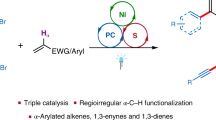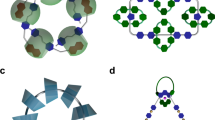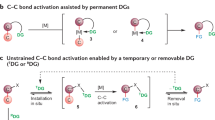Abstract
Mechanically interlocked molecules, such as rotaxanes and catenanes, are receiving increased attention as scaffolds for the development of new catalysts, driven by both their increasing accessibility and high-profile examples of the mechanical bond delivering desirable behaviours and properties. In this Review, we survey recent advances in the catalytic applications of mechanically interlocked molecules organized by the effect of the mechanical bond on key catalytic properties, namely, activity, chemoselectivity and stereoselectivity, and focus on how the mechanically bonded structure leads to the observed behaviour. Our aim is to inspire future investigations of mechanically interlocked catalysts, including those outside of the supramolecular community.

This is a preview of subscription content, access via your institution
Access options
Access Nature and 54 other Nature Portfolio journals
Get Nature+, our best-value online-access subscription
$29.99 / 30 days
cancel any time
Subscribe to this journal
Receive 12 digital issues and online access to articles
$119.00 per year
only $9.92 per issue
Buy this article
- Purchase on Springer Link
- Instant access to full article PDF
Prices may be subject to local taxes which are calculated during checkout








Similar content being viewed by others
Change history
28 January 2022
Some bonds shown in a structure in figure 7c were misaligned. This has now been corrected in all versions of the article.
References
Bruns, C. J. & Stoddart, J. F. The Nature of the Mechanical Bond: from Molecules to Machines (Wiley, 2016).
Wasserman, E. The preparation of interlocking rings: a catenane. J. Am. Chem. Soc. 82, 4433–4434 (1960).
Harrison, I. T. & Harrison, S. Synthesis of a stable complex of a macrocycle and a threaded chain. J. Am. Chem. Soc. 89, 5723–5724 (1967).
Beves, J. E., Blight, B. A., Campbell, C. J., Leigh, D. A. & McBurney, R. T. Strategies and tactics for the metal-directed synthesis of rotaxanes, knots, catenanes, and higher order links. Angew. Chem. Int. Ed. 50, 9260–9327 (2011).
Denis, M. & Goldup, S. M. The active template approach to interlocked molecules. Nat. Rev. Chem. 1, 0061 (2017).
Stoddart, J. F. Dawning of the age of molecular nanotopology. Nano Lett. 20, 5597–5600 (2020).
Sauvage, J. P. From chemical topology to molecular machines (Nobel Lecture). Angew. Chem. Int. Ed. 56, 11080–11093 (2017).
Stoddart, J. F. Mechanically interlocked molecules (MIMs) — molecular shuttles, switches, and machines (Nobel Lecture). Angew. Chem. Int. Ed. 56, 11094–11125 (2017).
Feringa, B. L. The art of building small: from molecular switches to motors (Nobel Lecture). Angew. Chem. Int. Ed. 56, 11060–11078 (2017).
van Dijk, L. et al. Molecular machines for catalysis. Nat. Rev. Chem. 2, 0117 (2018).
Erbas-Cakmak, S., Leigh, D. A., McTernan, C. T. & Nussbaumer, A. L. Artificial molecular machines. Chem. Rev. 115, 10081–10206 (2015).
Bąk, K. M., Porfyrakis, K., Davis, J. J. & Beer, P. D. Exploiting the mechanical bond for molecular recognition and sensing of charged species. Mater. Chem. Front. 4, 1052–1073 (2020).
Pairault, N. et al. Rotaxane-based architectures for biological applications. C. R. Chim. 19, 103–112 (2016).
Mayumi, K., Ito, K. & Kato, K. Polyrotaxane and Slide-Ring Materials (Royal Society of Chemistry, 2016).
Takata, T. Switchable polymer materials controlled by rotaxane macromolecular switches. ACS Cent. Sci. 6, 129–143 (2020).
Hoyas Perez, N. & Lewis, J. E. M. Synthetic strategies towards mechanically interlocked oligomers and polymers. Org. Biomol. Chem. 18, 6757–6780 (2020).
Frampton, M. J. & Anderson, H. L. Insulated molecular wires. Angew. Chem. Int. Ed. 46, 1028–1064 (2007).
Leigh, D. A., Marcos, V. & Wilson, M. R. Rotaxane catalysts. ACS Catal. 4, 4490–4497 (2014).
Martinez-Cuezva, A., Saura-Sanmartin, A., Alajarin, M. & Berna, J. Mechanically interlocked catalysts for asymmetric synthesis. ACS Catal. 10, 7719–7733 (2020).
Kauerhof, D. & Niemeyer, J. Functionalized macrocycles in supramolecular organocatalysis. ChemPlusChem 85, 889–899 (2020).
Kwamen, C. & Niemeyer, J. Functional rotaxanes in catalysis. Chem. Eur. J. 27, 175–186 (2021).
Jamieson, E. M. G., Modicom, F. & Goldup, S. M. Chirality in rotaxanes and catenanes. Chem. Soc. Rev. 47, 5266–5311 (2018).
Olivo, G., Capocasa, G., Del Giudice, D., Lanzalunga, O. & Di Stefano, S. New horizons for catalysis disclosed by supramolecular chemistry. Chem. Soc. Rev. 50, 7681–7724 (2021).
Heard, A. W. & Goldup, S. M. Simplicity in the design, operation, and applications of mechanically interlocked molecular machines. ACS Cent. Sci. 6, 117–128 (2020).
Albrecht-Gary, A. M., Saad, Z., Dietrich-Buchecker, C. O. & Sauvage, J. P. Interlocked macrocyclic ligands: a kinetic catenand effect in copper(I) complexes. J. Am. Chem. Soc. 107, 3205–3209 (1985).
Winn, J., Pinczewska, A. & Goldup, S. M. Synthesis of a rotaxane Cu(I) triazolide under aqueous conditions. J. Am. Chem. Soc. 135, 13318–13321 (2013).
Caputo, C. B., Zhu, K., Vukotic, V. N., Loeb, S. J. & Stephan, D. W. Heterolytic activation of H2 using a mechanically interlocked molecule as a frustrated Lewis base. Angew. Chem. Int. Ed. 52, 960–963 (2013).
Barat, R. et al. A mechanically interlocked molecular system programmed for the delivery of an anticancer drug. Chem. Sci. 6, 2608–2613 (2015).
Acevedo-Jake, A. et al. AT-CuAAC synthesis of mechanically interlocked oligonucleotides. J. Am. Chem. Soc. 142, 5985–5990 (2020).
Hudson, B. & Vinograd, J. Catenated circular DNA molecules in HeLa cell mitochondria. Nature 216, 647–652 (1967).
Hegemann, J. D., Zimmermann, M., Xie, X. & Marahiel, M. A. Lasso peptides: an intriguing class of bacterial natural products. Acc. Chem. Res. 48, 1909–1919 (2015).
Hoekman, S., Kitching, M. O., Leigh, D. A., Papmeyer, M. & Roke, D. Goldberg active template synthesis of a [2]rotaxane ligand for asymmetric transition-metal catalysis. J. Am. Chem. Soc. 137, 7656–7659 (2015).
Lee, Y. J. et al. Na+ ions induce the pirouetting motion and catalytic activity of [2]rotaxanes. Chem. Eur. J. 23, 9756–9760 (2017).
Hamza, A., Schubert, G., Soos, T. & Papai, I. Theoretical studies on the bifunctionality of chiral thiourea-based organocatalysts: competing routes to C–C bond formation. J. Am. Chem. Soc. 128, 13151–13160 (2006).
Zhu, J. L., Zhang, Y., Liu, C., Zheng, A. M. & Wang, W. Insights into the dual activation mechanism involving bifunctional cinchona alkaloid thiourea organocatalysts: an NMR and DFT study. J. Org. Chem. 77, 9813–9825 (2012).
Lim, J. Y. C., Yuntawattana, N., Beer, P. D. & Williams, C. K. Isoselective lactide ring opening polymerisation using [2]rotaxane catalysts. Angew. Chem. Int. Ed. 58, 6007–6011 (2019).
Dove, A. P., Pratt, R. C., Lohmeijer, B. G., Waymouth, R. M. & Hedrick, J. L. Thiourea-based bifunctional organocatalysis: supramolecular recognition for living polymerization. J. Am. Chem. Soc. 127, 13798–13799 (2005).
Kihara, N., Tachibana, Y., Kawasaki, H. & Takata, T. Unusually lowered acidity of ammonium group surrounded by crown ether in a rotaxane system and its acylative neutralization. Chem. Lett. 29, 506–507 (2000).
Ragazzon, G. et al. Remote electrochemical modulation of pKa in a rotaxane by co-conformational allostery. Proc. Natl Acad. Sci. USA 115, 9385–9390 (2018).
Pairault, N. et al. Heterobifunctional rotaxanes for asymmetric catalysis. Angew. Chem. Int. Ed. 59, 5102–5107 (2020).
Perez, Jd. M. et al. Mechanical bonding activation in rotaxane-based organocatalysts. Org. Chem. Front. 8, 4202–4210 (2021).
Fang, Y. et al. Catalytic reactions within the cavity of coordination cages. Chem. Soc. Rev. 48, 4707–4730 (2019).
Marcos, V. et al. Allosteric initiation and regulation of catalysis with a molecular knot. Science 352, 1555–1559 (2016).
Prakasam, T. et al. Metal-organic self-assembled trefoil knots for C-Br bond activation. ACS Catal. 9, 1907–1914 (2019).
Kassem, S. et al. Stereodivergent synthesis with a programmable molecular machine. Nature 549, 374–378 (2017).
Blanco, V., Carlone, A., Hanni, K. D., Leigh, D. A. & Lewandowski, B. A rotaxane-based switchable organocatalyst. Angew. Chem. Int. Ed. 51, 5166–5169 (2012).
Blanco, V., Leigh, D. A., Marcos, V., Morales-Serna, J. A. & Nussbaumer, A. L. A switchable [2]rotaxane asymmetric organocatalyst that utilizes an acyclic chiral secondary amine. J. Am. Chem. Soc. 136, 4905–4908 (2014).
Blanco, V., Leigh, D. A., Lewandowska, U., Lewandowski, B. & Marcos, V. Exploring the activation modes of a rotaxane-based switchable organocatalyst. J. Am. Chem. Soc. 136, 15775–15780 (2014).
Biagini, C. et al. Dissipative catalysis with a molecular machine. Angew. Chem. Int. Ed. 58, 9876–9880 (2019).
Jaramillo, P., Pérez, P. & Fuentealba, P. Relationship between basicity and nucleophilicity. J. Phys. Org. Chem. 20, 1050–1057 (2007).
Martinez-Cuezva, A. et al. Photoswitchable interlocked thiodiglycolamide as a cocatalyst of a chalcogeno-Baylis–Hillman reaction. Chem. Sci. 8, 3775–3780 (2017).
Blanco, V., Leigh, D. A. & Marcos, V. Artificial switchable catalysts. Chem. Soc. Rev. 44, 5341–5370 (2015).
Teator, A. J., Lastovickova, D. N. & Bielawski, C. W. Switchable polymerization catalysts. Chem. Rev. 116, 1969–1992 (2016).
Deacy, A. C., Gregory, G. L., Sulley, G. S., Chen, T. T. D. & Williams, C. K. Sequence control from mixtures: switchable polymerization catalysis and future materials applications. J. Am. Chem. Soc. 143, 10021–10040 (2021).
Suzaki, Y. et al. [3]Rotaxane-based dinuclear palladium catalysts for ring-closure Mizoroki–Heck reaction. Org. Lett. 13, 3774–3777 (2011).
Hsueh, F. C. et al. N-heterocyclic carbene copper(I) rotaxanes mediate sequential click ligations with all reagents premixed. Angew. Chem. Int. Ed. 59, 11278–11282 (2020).
Beswick, J. et al. Selecting reactions and reactants using a switchable rotaxane organocatalyst with two different active sites. Chem. Sci. 6, 140–143 (2015). An impressive demonstration of using a switchable catalyst based on a mechanically interlocked molecule molecular shuttle to control multiple chemical reactions.
Eichstaedt, K. et al. Switching between anion-binding catalysis and aminocatalysis with a rotaxane dual-function catalyst. J. Am. Chem. Soc. 139, 9376–9381 (2017).
Martinez-Cuezva, A., Lopez-Leonardo, C., Bautista, D., Alajarin, M. & Berna, J. Stereocontrolled synthesis of beta-lactams within [2]rotaxanes: showcasing the chemical consequences of the mechanical bond. J. Am. Chem. Soc. 138, 8726–8729 (2016). An example of an organocatalysed reaction in the framework of a rotaxane whose outcome is dictated by the mechanical bond.
Modicom, F., Jamieson, E. M. G., Rochette, E. & Goldup, S. M. Chemical consequences of the mechanical bond: a tandem active template-rearrangement reaction. Angew. Chem. Int. Ed. 58, 3875–3879 (2019).
Leforestier, B., Gyton, M. R. & Chaplin, A. B. Oxidative addition of a mechanically entrapped C(sp)–C(sp) bond to a rhodium(I) pincer complex. Angew. Chem. Int. Ed. 59, 23500–23504 (2020). An exciting demonstration of the ability of the mechanical bond to generate unique reactivity, a principle that could provide breakthroughs in mechanically interlocked molecule catalysis.
Zhu, L., Li, J., Yang, J. & Au-Yeung, H. Y. Cross dehydrogenative C–O coupling catalysed by a catenane-coordinated copper(I). Chem. Sci. 11, 13008–13014 (2020).
Tachibana, Y., Kihara, N. & Takata, T. Asymmetric benzoin condensation catalyzed by chiral rotaxanes tethering a thiazolium salt moiety via the cooperation of the component: can rotaxane be an effective reaction field? J. Am. Chem. Soc. 126, 3438–3439 (2004). The first example of enantioselective catalysis with a chiral mechanically interlocked molecule in which the principle of chiral information transfer between the components is clearly demonstrated.
Johansson, M. J., Gorin, D. J., Staben, S. T. & Toste, F. D. Gold(I)-catalyzed stereoselective olefin cyclopropanation. J. Am. Chem. Soc. 127, 18002–18003 (2005).
Galli, M., Lewis, J. E. & Goldup, S. M. A stimuli-responsive rotaxane–gold catalyst: regulation of activity and diastereoselectivity. Angew. Chem. Int. Ed. 54, 13545–13549 (2015).
Poater, A. et al. SambVca: a web application for the calculation of the buried volume of N-heterocyclic carbene ligands. Eur. J. Inorg. Chem. 2009, 1759–1766 (2009).
Calles, M. et al. Enhancing the selectivity of prolinamide organocatalysts using the mechanical bond in [2]rotaxanes. Chem. Sci. 11, 3629–3635 (2020).
Dommaschk, M., Echavarren, J., Leigh, D. A., Marcos, V. & Singleton, T. A. Dynamic control of chiral space through local symmetry breaking in a rotaxane organocatalyst. Angew. Chem. Int. Ed. 58, 14955–14958 (2019). A molecular shuttle in which the different mechanical states of the switch create pseudo-enantiomeric environments around a catalytic functional group.
Ryabchun, A., Li, Q., Lancia, F., Aprahamian, I. & Katsonis, N. Shape-persistent actuators from hydrazone photoswitches. J. Am. Chem. Soc. 141, 1196–1200 (2019).
Shao, B. & Aprahamian, I. Hydrazones as new molecular tools. Chem 6, 2162–2173 (2020).
Mitra, R., Zhu, H., Grimme, S. & Niemeyer, J. Functional mechanically interlocked molecules: asymmetric organocatalysis with a catenated bifunctional Brønsted acid. Angew. Chem. Int. Ed. 56, 11456–11459 (2017). The first example of enantioselective catalysis using a catenane, including a clear demonstration of the potential for the flexible environment of the mechanical bond to enhance selectivity by increasing the effective molarity of cooperating catalytic functional groups.
Jansen, D. et al. What is the role of acid–acid interactions in asymmetric phosphoric acid organocatalysis? A detailed mechanistic study using interlocked and non-interlocked catalysts. Chem. Sci. 11, 4381–4390 (2020).
Kirby, A. J. in Advances in Physical Organic Chemistry (ed. Gold, V. & Bethell, D.) 183–278 (Academic, 1980).
Di Stefano, S. & Mandolini, L. The canonical behavior of the entropic component of thermodynamic effective molarity. An attempt at unifying covalent and noncovalent cyclizations. Phys. Chem. Chem. Phys. 21, 955–987 (2019).
Martinez-Cuezva, A. et al. Interlocking the catalyst: thread versus rotaxane-mediated enantiodivergent Michael addition of ketones to beta-nitrostyrene. Org. Lett. 21, 5192–5196 (2019).
Xu, K., Nakazono, K. & Takata, T. Design of rotaxane catalyst for O-acylative asymmetric desymmetrization of meso-1,2-diol utilizing the cooperative effect of the components. Chem. Lett. 45, 1274–1276 (2016).
Cakmak, Y., Erbas-Cakmak, S. & Leigh, D. A. Asymmetric catalysis with a mechanically point-chiral rotaxane. J. Am. Chem. Soc. 138, 1749–1751 (2016).
Heard, A. W. & Goldup, S. M. Synthesis of a mechanically planar chiral rotaxane ligand for enantioselective catalysis. Chem 6, 994–1006 (2020). The first demonstration of enantioselective catalysis using a mechanical stereogenic unit.
Bordoli, R. J. & Goldup, S. M. An efficient approach to mechanically planar chiral rotaxanes. J. Am. Chem. Soc. 136, 4817–4820 (2014).
Jinks, M. A. et al. Stereoselective synthesis of mechanically planar chiral rotaxanes. Angew. Chem. Int. Ed. 57, 14806–14810 (2018).
Wang, Y. M., Lackner, A. D. & Toste, F. D. Development of catalysts and ligands for enantioselective gold catalysis. Acc. Chem. Res. 47, 889–901 (2014).
Ishiwari, F., Nakazono, K., Koyama, Y. & Takata, T. Induction of single-handed helicity of polyacetylenes using mechanically chiral rotaxanes as chiral sources. Angew. Chem. Int. Ed. 56, 14858–14862 (2017).
Denis, M., Lewis, J. E. M., Modicom, F. & Goldup, S. M. An auxiliary approach for the stereoselective synthesis of topologically chiral catenanes. Chem 5, 1512–1520 (2019).
Maynard, J. R. J. & Goldup, S. M. Strategies for the synthesis of enantiopure mechanically chiral molecules. Chem 6, 1914–1932 (2020).
Hattori, G., Hori, T., Miyake, Y. & Nishibayashi, Y. Design and preparation of a chiral ligand based on a pseudorotaxane skeleton: application to rhodium-catalyzed enantioselective hydrogenation of enamides. J. Am. Chem. Soc. 129, 12930–12931 (2007).
Gil-Ramirez, G. et al. Tying a molecular overhand knot of single handedness and asymmetric catalysis with the corresponding pseudo-D3-symmetric trefoil knot. J. Am. Chem. Soc. 138, 13159–13162 (2016).
Berna, J., Alajarin, M. & Orenes, R. A. Azodicarboxamides as template binding motifs for the building of hydrogen-bonded molecular shuttles. J. Am. Chem. Soc. 132, 10741–10747 (2010).
Lewandowski, B. et al. Sequence-specific peptide synthesis by an artificial small-molecule machine. Science 339, 189–193 (2013).
Agouridas, V. et al. Native chemical ligation and extended methods: mechanisms, catalysis, scope, and limitations. Chem. Rev. 119, 7328–7443 (2019).
De, Bo,G. et al. An artificial molecular machine that builds an asymmetric catalyst. Nat. Nanotechnol. 13, 381–385 (2018). An impressive demonstration of the ability of mechanical motion to control the multistep synthesis of a functional biopolymer.
McTernan, C. T., De, Bo,G. & Leigh, D. A. A track-based molecular synthesizer that builds a single-sequence oligomer through iterative carbon-carbon bond formation. Chem 6, 2964–2973 (2020).
Wilson, M. R. et al. An autonomous chemically fuelled small-molecule motor. Nature 534, 235–240 (2016).
Astumian, R. D. Kinetic asymmetry allows macromolecular catalysts to drive an information ratchet. Nat. Commun. 10, 3837 (2019).
Borsley, S., Leigh, D. A. & Roberts, B. M. W. A doubly kinetically-gated information ratchet autonomously driven by carbodiimide hydration. J. Am. Chem. Soc. 143, 4414–4420 (2021).
Chauvin, Y. Olefin metathesis: the early days (Nobel Lecture). Angew. Chem. Int. Ed. 45, 3740–3747 (2006).
Schrock, R. R. Multiple metal–carbon bonds for catalytic metathesis reactions (Nobel Lecture). Angew. Chem. Int. Ed. 45, 3748–3759 (2006).
Grubbs, R. H. Olefin-metathesis catalysts for the preparation of molecules and materials (Nobel Lecture). Angew. Chem. Int. Ed. 45, 3760–3765 (2006).
Frisch, H. L. & Wasserman, E. Chemical topology. J. Am. Chem. Soc. 83, 3789–3795 (1961).
Schill, G. & Lüttringhaus, A. The preparation of catena compounds by directed synthesis. Angew. Chem. Int. Ed. 3, 546–547 (1964).
Dietrich-Buchecker, C. O. & Sauvage, J. P. Synthese de composes polyethers macrocycliques derives de la phenanthroline-1,10 diphenyl-2,9. Tetrahedron Lett. 24, 5091–5094 (1983).
Yamamoto, C., Okamoto, Y., Schmidt, T., Jager, R. & Vogtle, F. Enantiomeric resolution of cycloenantiomeric rotaxane, topologically chiral catenane, and pretzel-shaped molecules: observation of pronounced circular dichroism. J. Am. Chem. Soc. 119, 10547–10548 (1997).
Aucagne, V., Hanni, K. D., Leigh, D. A., Lusby, P. J. & Walker, D. B. Catalytic “click” rotaxanes: a substoichiometric metal-template pathway to mechanically interlocked architectures. J. Am. Chem. Soc. 128, 2186–2187 (2006).
Acknowledgements
A.W.H. thanks the University of Southampton for a Presidential Scholarship. J.M.S. thanks the Royal Society for a Newton International Fellowship. S.M.G. thanks the European Research Council (Consolidator Grant agreement 724987) for funding. S.M.G. is a Royal Society Wolfson Research Fellow.
Author information
Authors and Affiliations
Contributions
All authors researched data for the article, contributed substantially to discussion of the content and contributed to the writing of the article. S.M.G. finalized the article text. All authors reviewed and commented on the manuscript before submission.
Corresponding author
Ethics declarations
Competing interests
The authors declare no competing interests.
Additional information
Peer review information
Nature Reviews Chemistry thanks S. Di Stefano and the other, anonymous, reviewer(s) for their contribution to the peer review of this work.
Publisher’s note
Springer Nature remains neutral with regard to jurisdictional claims in published maps and institutional affiliations.
Rights and permissions
About this article
Cite this article
Heard, A.W., Suárez, J.M. & Goldup, S.M. Controlling catalyst activity, chemoselectivity and stereoselectivity with the mechanical bond. Nat Rev Chem 6, 182–196 (2022). https://doi.org/10.1038/s41570-021-00348-4
Accepted:
Published:
Issue Date:
DOI: https://doi.org/10.1038/s41570-021-00348-4
This article is cited by
-
Look what the catenane dragged in
Nature Reviews Chemistry (2023)
-
Stimuli-responsive rotaxane-branched dendronized polymers with tunable thermal and rheological properties
Nature Communications (2023)
-
Ratcheting synthesis
Nature Reviews Chemistry (2023)
-
Switchable aqueous catalytic systems for organic transformations
Communications Chemistry (2022)



